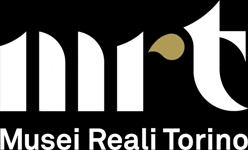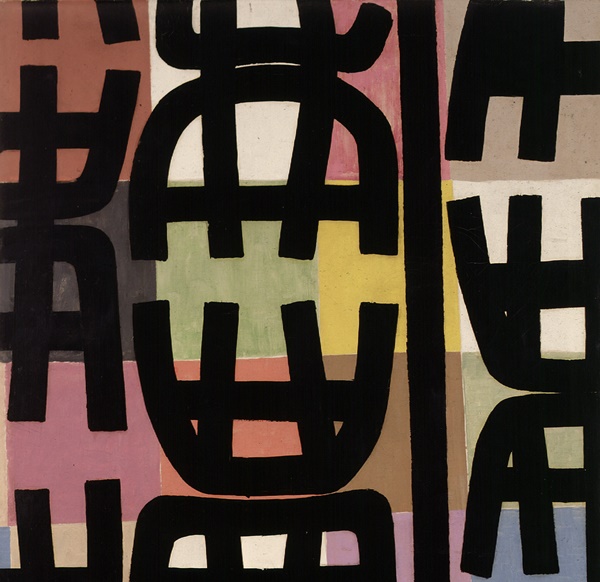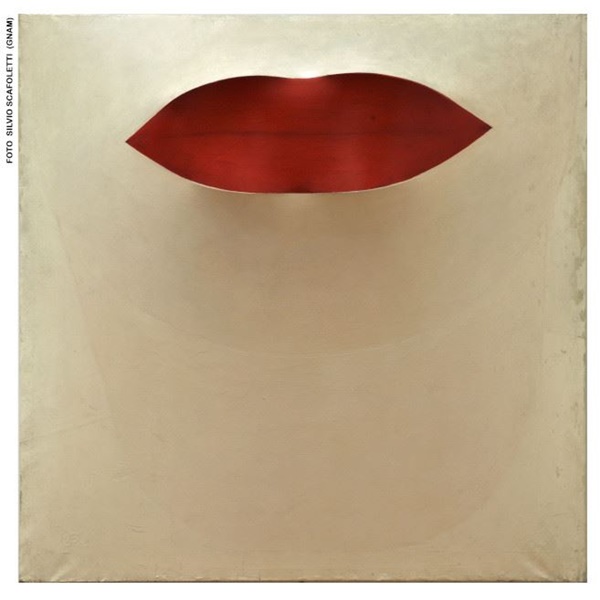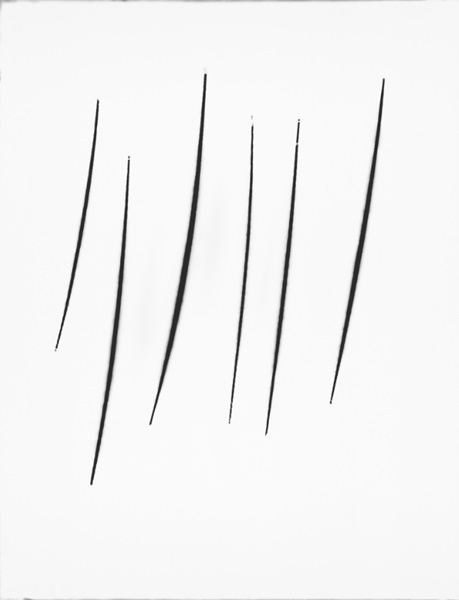"1950-1970 La grande arte italiana"
Ettore Colla, Pino Pascali, Giuseppe Capogrossi, Lucio Fontana, Alberto Burri, Mimmo Rotella, Bice Lazzari, Afro Basaldella, Piero Dorazio, Giosetta Fioroni, Carla Accardi, Giulio Turcato, Gastone Novelli, Toti Scialoja, Sergio Lombardo, Tano Festa, Franco Angeli, Piero Manzoni, Michelangelo Pistoletto, Mario Schifano, Emilio Isgrò
Produced by Musei Reali and Arthemisia with the National Gallery of Modern and Contemporary Art, the exhibition is curated by the director of GNAM Renata Cristina Mazzantini with the scholar Luca Massimo Barbero, desired and made possible by Mario Turetta, Head of the Department for Cultural Activities of the Ministry of Culture and managing director of the Royal Museums of Turin.

Musei Reali
Piazzetta Reale, 1, Turin, Italy ![]()
Tel. +39 011 1956 0449 e-mail:
19.10, 2024 > 02.03, 2025

Capogrossi Giuseppe Superficie 207, 1957 Olio su tela, 180x120 cm © Giuseppe Capogrossi, by SIAE 2024

Pascali Pino Primo piano labbra, 1964 Tela smaltata tensionata su struttura lignea con camere d'aria, 165x165x30 cm

Fontana Lucio Concetto spaziale. Attese, 1963 Idropittura su tela con tagli, garze nere, 91x73,5 cm © Fondazione Lucio Fontana, Milano
The exhibition itinerary clearly highlights the origins of what was a real “movement artistic telluric”. “It's an intense journey – declares Luca Massimo Barbero – and, in addition to the many rooms, it's a real one melee between the "new masters" of post-war Italian art, whose roots are explored here and, for the first time, it is possible to compare them outside the GNAM collection. For Italian art yes it deals with the germinal protagonists, today identified as the international interpreters of the time contemporaneity."
 Ettore Colla
Ettore Colla  Pino Pascali
Pino Pascali mail :
web : http://www.museopinopascali.it/
country : ITALY
city : POLIGNANO A MARE BA
Pino Pascali was born in Bari, Italy in 1935 and moved to Rome in 1955 to learn scene painting and set design at the Academy of Art. Pascali worked as an advertisement illustrator and designer for a number of years before his first solo exhibition in 1965 at the Galleria La Tartaruga. Pascali showed his "fake sculptures," a series of shaped-canvases that first appear to be solid sculptures but are actually paintings that present abstract forms suggesting animals, plants and landscapes. Soon after, Pascali created his "weapon series," which is perhaps his most famous group of works. Assembled from found materials and painted olive-green, it faithfully recreates every detail of the weapon it mimics. However, as the weapon cannot fire or kill, it becomes an innocent, oversized toy. Opposite to the "weapon series" in appearance, Pascali presented organic forms in a dream-like universe that, like the "fake sculptures," play on the relationship between illusion and reality. In 1968, Pascali died tragically in a motorcycle accident at the young age of thirty-two. His all too-short career has served as an important contribution to post-war art.
 Giuseppe Capogrossi
Giuseppe Capogrossi  Lucio Fontana
Lucio Fontana mail :
web : http://www.fondazioneluciofontana.it/
country : ITALY
city : MILANO MI
Lucio Fontana was born on February 19, 1899, in Rosario de Santa Fé, Argentina. His father was Italian and his mother Argentinean. He lived in Milan from 1905 to 1922 and then moved back to Argentina, where he worked as a sculptor in his father's studio for several years before opening his own. In 1926, he participated in the first exhibition of Nexus (formed in 1907), a group of young Argentinean artists in Rosario de Santa Fé. On his return to Milan in 1928, Fontana enrolled at the Accademia di belle arti di Brera, which he attended for two years. The Galleria del Milione, Milan, organized Fontana's first solo exhibition in 1930. In 1934, he joined the group of abstract Italian sculptors associated with the gallery. The artist traveled to Paris in 1935 and joined the group Abstraction-Création (Abstraction Creation, 1931–36). The same year, he developed his skills in ceramics in Albisola, Italy, and later at the Sèvres factory, near Paris. In 1939, he joined the Milanese anti-Fascist artists' group Corrente (Current, 1938–43). He also intensified his lifelong collaboration with architects during this period. In 1940, Fontana moved to Buenos Aires. With some of his students, he founded in 1946 the Academia de Altamira, from which emerged the "Manifesto blanco" (White manifesto, 1946). He moved back to Milan in 1947 and in collaboration with a group of writers and philosophers signed the "Primo manifesto dello spazialismo" (First manifesto of spatialism).
 Alberto Burri
Alberto Burri mail :
web : http://www.fondazioneburri.org/
country : ITALY
city : MILANO MI
Alberto Burri was born March 12, 1915, in Città di Castello, a small town in the Umbria region of Italy. In 1940 he received a degree in medicine from the Università degli Studi di Perugia. He served in the Ethiopian campaign and in World War II, first as a frontline soldier and then as a physician. Following his unit’s May 1943 capture in Tunisia, Burri was sent to a prisoner-of-war camp in Hereford, Texas. Disaffected by war and by his internment, he took up painting in an autodidactic, figurative style and never practiced medicine again. Burri developed a new material realism that stood apart from postwar gestural abstraction and its emotive and existentialist content. He blurred the boundaries between painting and relief sculpture and redefined the concept and the making of the monochrome. In the mid-1950s he turned to mass-produced industrial materials in prefabricated colors and developed a new technique of painting with combustion to make torched wood veneer works (Legni [woods]); welded reliefs of cold-rolled steel (Ferri [irons]); and compositions of melted and charred plastic (Combustioni plastiche [plastic combustions]).
 Mimmo Rotella
Mimmo Rotella mail :
web : http://www.fondazionemimmorotella.net/
country : ITALY
city : MILANO MI
Domenico “Mimmo” Rotella (Catanzaro, 7 October 1918 – Milan, 8 January 2006) was an Italian artist considered an important figure in post-war European art. Best known for his works of décollage and psychogeographics, made from torn advertising posters. He was associated to the Ultra-Lettrists an offshoot of Lettrism and later was a member of the Nouveau Réalisme, founded in 1960 by the art critic Pierre Restany.
 Bice Lazzari
Bice Lazzari mail :
web : https://www.archiviobicelazzari.com/
country : ITALY
city : ROME
Bice Lazzari (1900 – 1981) was one of the protagonists of the twentieth century, an independent woman who was far ahead of her time. She devoted her entire life to art, succeeding in establishing herself in a field that was not considered appropriate for a woman at the time. She began to attend decoration courses at the Accademia di Belle Arti in Venice in 1916, although she preferred painting courses, which were barred to her because of the nude lessons considered unsuitable for a young lady from a good family. A forerunner of abstract, conceptual and very contemporary painting, from a young age she worked in the field of applied art, considered more suitable for a female artist, working with the most fashionable architects of the 1930s and 1940s. Over the course of her life, Bice Lazzari produced an important body of works on canvas and paper, ranging from the figurative works of her youth to the informal experiments of the 1950s – 1960s, to the perfect geometric abstraction that she practised from the mid–1960s to the early 1980s.
 Afro Basaldella
Afro Basaldella mail : not available
web : https://afrobasaldella.org/
country : ITALY
city : ROME
Afro Basaldella (Udine, 4 March 1912 – Zurich, 24 July 1976) was a crucial figure for understanding the relationship between Italian painting and the context of international contemporary art. Already in 1950, in fact, Afro was in New York to collaborate, thanks to the intercession of his friend Corrado Cagli, with the Catherine Viviano Gallery, moving from neocubist to abstract painting thanks to that at his encounter, in the United States, with American Abstract Expressionism, from which he learned automatisms linked to the gestures of painting. But Afro's painting remained significantly European because it was defined as an expression of 'abstract lyricism', a vague memory of the image persisted, never described, but always evoked; often in the suggestive titles that the artist gave to his works. At the beginning involved by luminous and tonal values, obtained through virtuosic glazes (Ombra burnt), over the years Sixty Afro accentuates the gestural component (The castle), to arrive, over the course of the decade later, to the final results of his painting in works such as the Great Ocher, where the different shades are enclosed in clear backgrounds, as if they were inlays. A re-appropriation of the constructivist instance where the gesture, which had previously been liberating, now becomes restrained and controlled.
 Piero Dorazio
Piero Dorazio  Giosetta Fioroni
Giosetta Fioroni  Carla Accardi
Carla Accardi  Giulio Turcato
Giulio Turcato  Gastone Novelli
Gastone Novelli mail :
web : https://www.gastonenovelli.it/
country : ITALY
city : ROME
Gastone Novelli was born in Vienna on August 1, 1925. He received a classical education in Rome, where he had moved with his family, and became involved in the Italian resistance movement in 1943. He was arrested and then freed the following year. In 1945 he moved to Florence and earned a degree in political science. After the war he started painting and producing graphic works that were greatly influenced by the Neo-Constructivist theories of Max Bill, who he had met while staying in Zurich in 1947. In 1950 he moved to Brazil and devoted himself to the applied arts, teaching, and research into Geometrical Abstraction. In 1951 and 1953 he participated in the São Paulo Bienal. In December 1954 he went back to Rome and met Corrado Cagli and Achille Perilli; the following year he exhibited at the Galleria La Cassapanca and Studio B24. In 1959 he exhibited in the Galleria l’Ariete in Milan and participated in many groups shows in Italy and abroad. In 1960 he had a solo exhibition at the Galleria La Tartaruga in Rome and took part in the show Crack at the Galleria Il Canale in Venice. The following year he returned to Paris once again, where he met Geroges Bataille, Samuel Beckett, Pierre Klossowski, and Claude Simon, and had a private show at the Galerie du Fleuve. In 1962 his work was shown at the Alan Gallery in New York, and he spent some time travelling in Greece.
 Toti Scialoja
Toti Scialoja mail :
web : https://totiscialoja.it/
country : ITALY
city : ROME
Antonio "Toti" Scialoja was born in Rome on December 16, 1914.In the late 1930s he joined the artistic and literary circles of the Galleria La Cometa. In 1937, Scialoja gave up his law studies and devoted himself entirely to painting. During this period he produced his first Expressionist paintings,in which his use of thick, textural brushstrokes was clearly influenced by French painting, in particular Chaim Soutine. In 1939 he exhibited at the 3rd Rome Quadriennale and in 1941 he had a solo exhibition at the Società Amici dell’Arte in Turin. The following year he took part in a group show at the Galleria Lo Zodiaco in Rome, along with Leoncillo Leonardi,Giulio Turcato, and Emilio Vedova. He was actively involved in the Italian resistance movement, and worked for the theater, designing his first stage sets in 1943. In 1957 he create his first Impronte series,in which traces of color are printed from one surface onto the other, and onto diverse materials ranging from paper to canvas. During this period, Scialoja took part in important national and international shows. in 1960 he moved first to New York and then from 1961 to 1963 to Paris. Back in Italy in 1964,he exhibited at the Venice Biennale. His artistic production ceased for a prolonged period during the 1970s, and he only resumed painting in 1983. Scialoja was also a poet,writer,and set designer. He taught at the Academy of Fine Arts in Rome and served as its director for many years. He died in Rome on March 1, 1998.
 Sergio Lombardo
Sergio Lombardo mail :
web : http://www.sergiolombardo.it
country : ITALY
city : ROME
Born 1939, Rome, Italy, where he lives and works. At a very young age, Sergio Lombardo abandoned his studies in law and psychology to pursue his passion for art. His first body of work, produced between 1958 and 1961, was a series of paintings made of paper squares pasted on canvas in the shape of a grid, coated with layers of monochrome enamel. Lombardo opposed the notion of the artist-as-genius, and sought to produce works that were non-artistic, drained of any subjective mark. From 1961 he grew closer to the Scuola di Piazza del Popolo (Piazza del Popolo School, also known as the Pop artists of Rome), composed of Mario Schifano, Cesare Tacchi and Renato Mambor among others, participating in some of the most important group exhibitions at the Galleria Tartaruga. As he developed a greater aperture towards the world of the mass media, he began to work on the series Gesti Tipici (Typical Gestures 1961–3), which portrayed, first in black in white, then also in colour, some of the most relevant and iconic political figures of the time, including Malcolm X, McNamara, Rockefeller, and De Gaulle. The works Nikita Krusciov and John F. Kennedy, both from 1962, depict the black and white silhouettes of the politicians, leaders of the world’s two superpowers during the Cold War. Belonging to the series Typical Gestures (first exhibited at the Galleria Tartaruga in 1963), the works immortalise the authoritative postures, and formal clothing of the figures.
 Tano Festa
Tano Festa mail :
web : https://www.tanofesta.it/
country : ITALY
city : ROME
Tano Festa, younger brother of the artist Francesco Lo Savio, attends the Art Institute in Rome, graduating in Artistic Photography in 1957. Two years later he takes part in his first group show, Franco Angeli - Tano Festa - Giuseppe Uncini at La Salita Gallery in Rome, where he also holds his first solo exhibition in 1959. In 1960 he makes his first monochrome paintings in red, with lines marked out with pieces of paper soaked in the color. This new approach is deemed anti-representational, aniconic, monochrome painting. Soon after, the surface of his paintings is no longer marked out with paper, but rather with wooden slats arranged vertically at irregular intervals. Tano Festa’s painting has always been filled with expressive energy contaminated by the need to perceive the object of everyday use as the foundation of art: shutters, doors, windows, and mirrors no longer perform their function as objects but, as they are painted, they become artworks. In 1964 he is invited to the Venice Biennale where the two versions of La Creazione dell’Uomo are displayed. In the early 1970s, the artist starts experimenting with new art techniques relying more on the pictorial matter, gesture, and color. The images are still drawn from art history, projected on the canvas but re-proposed in a more fragmented manner.
 Franco Angeli
Franco Angeli mail :
web : https://archiviofrancoangeli.org/
country : ITALY
city : ROME
Franco Angeli was an Italian artist. He started his career in the Roman city center in the mid-50s in an artistic atmosphere of strong vivacity, with friends Tano Festa and Mario Schifano, from the School of Piazza del Popolo. Interested in the experimentation of Informal Art, already in 1958, he began a reflection on the monochromes that he created through the use of canvas covered with pulled, torn nylon. Since his first solo exhibition at “Galleria La Salita”, in Rome, Franco Angeli has been passionately interested, throughout the decade, in the political climate, with a consequent influence in his work: his paintings and works on paper were marked by parades, student protests and mostly the very personal reworking of political symbols. In particular, a reflection on power and on visual rhetoric inspired him in creating a very personal and revelatory mythology. A new attention to a more intimate, familiar sphere, with a renewed attention to the landscape and to the figure, only emerged at the end of the Seventies.
 Piero Manzoni
Piero Manzoni mail :
web : http://www.pieromanzoni.org/
country : ITALY
city : MILANO MI
Piero Manzoni’s brief career was one of the most radically inventive of the twentieth century, producing a body of work that continues to challenge the definitions of artistic sovereignty and virtuosity. Piero Manzoni was born in 1933 in Soncino, Italy, and died in 1963 in Milan, Italy. His work has been the subject of numerous international exhibitions, including Herning Kunstmuseum, Germany (1991); Musée d'art Moderne de la Ville de Paris, France (1991); Castello di Rivoli—Museo d’Arte Contemporanea, Italy (1992); “Linee,” Palazzo delle Esposizioni, Rome (1995); “Line Drawings,” Museum of Contemporary Art, Los Angeles (1995); “Milano et mitologia,” Palazzo Reale, Milan (1997); MADRE Museum, Italy (2008); “When Bodies Became Art,” Stadel Museum, Germany (2013); Palazzo Reale, Italy (2014); and Museu de Arte Moderna, Brazil (2015).
 Michelangelo Pistoletto
Michelangelo Pistoletto mail :
web : http://www.pistoletto.it
country : ITALY
city : TURIN TO
Michelangelo Pistoletto was born in 1933 in Biella, Italy, where he continues to live and work today. In 1962, he initiated his Quadri specchianti (Mirror Paintings), for which he gained international recognition. A participant in New York’s Pop art scene and pioneer of the Arte Povera movement, he created his sculptural series Oggetti in meno (Minus Objects) in 1965–66 and began his evolving body ofVenere degli stracci (Venus in Rags) in 1967, both of which harness everyday materials. That same year, he began orchestrating happenings and performances outside of traditional exhibition spaces and founded the interdisciplinary theater troupe Lo Zoo (The Zoo) in 1968. In the 1990s, he established Cittadellarte – Fondazione Pistoletto, placing social change at the heart of his practice. He recently publishedOminiteismo e demopraxia. Manifesto per una rigenerazione della società (Hominitheism and Demopraxy: Manifesto for the Regeneration of Society, Chiarelettere, 2017) andLa formula della creazione (The Formula of Creation, Edizioni Cittadellarte, 2022). In 2023, Pistoletto presented a series of new works that employed QR code and AI technologies, coining the termmetaopera. He has been the recipient of numerous international awards, including the Golden Lion for Lifetime Achievement at the Venice Biennale (2003), Wolf Prize from the Wolf Foundation (2007), and the Praemium Imperiale for Painting from the Japan Art Association (2013). The artist’s paintings and scul
 Mario Schifano
Mario Schifano mail :
web : http://www.marioschifano.it/
country : ITALY
city : ROME
It was in that period that he painted the anaemic landscapes, where the natural world was transferred on the thread of memory trough fragments, details and allusive writings. The artist worked by thematic cycles and by the end of 1964 he marked the interest towards the re visitation of the history of art, which the following year would have brought him to those famous artworks dedicated to Futurism. In 1965 he exhibited at the Biennial in San Marino and in San Paolo in Brazil. He was also the author of some underground movies. At the beginning of the ’70s Schifano started to reproduce some TV-images directly on emulsified canvas, setting them apart from the narrative rhythm they belonged to and re proposing them with some touches of nitre colours. The TV-image was fatuous, evanescent and immaterial, of quick use. When it was transferred on canvas and it was transformed by the artist, who in the meanwhile had assimilated it, it acquired a stable value and other meaning. After a long period in which Schifano was contented between ideological and existential fears, that of course would have influenced his creative talent and brought him far from the artistic scene, he will took interest in painting towards the end of the ‘70s. He was invited to several exhibitions, like the Biennial of Venice in 1982 and 1984. This was the period of his landscapes, his water-lilies, his cornfields, the movements of sea, the extents of sand re-created trough memories and sensations.
 Emilio Isgrò
Emilio Isgrò mail :
web : http://www.archivioemilioisgro.info
country : ITALY
city : MILANO MI
Born on 1937 at Barcellona di Pozzo, Sicily, Emilio Isgrò lives and works in Milan. Conceptual artist and painter- but also poet, writer, dramaturge and director- Emilio Isgrò is considered one of the most internationally renowned and prestigious names of the Italian art scene of the XX and XXI century, together with Piero Manzoni and Lucio Fontana. Isgrò work can be considered among the most revolutionary and original within the so called Vanguardias of the year 60s. The Artist is the undisputed author of the ‘Cancellation (erasure technique)’ – the act of striking out the words of a printed book – something he began to explore in the early 1960s; Emilio Isgrò has made the ‘cancellation’ his poetic, although erasing is not to be considered as a metaphor in his practice, but as a actual action. He works on texts of real ‘covers’, transforming and renewing the meaning, without annihilating or destroying the value of the word or the image. As a pioneer of the ‘erasure’ of texts, encyclopedias, manuscripts, books, maps and even movie films, Emilio Isgrò has made his technique the essence of his research. He looks towards a sort of reverse reading and re-interpretation of the language which, through various manipulations, goes from being verbal to being visual. As the Artist himself says: ”Erasures is not a simple negation, but instead it is the statement of new meanings: it is the transformation of a negative sign into a positive gesture”.
Closed on Monday
Tuesday – Sunday 9.30 – 19.30
(the ticket office closes one hour early)
Extraordinary openings
Monday 4 November 9.30 – 19.30
Tuesday 24 December 9.30 – 17.30
Wednesday 25 December 12.00 – 19.30
Monday 30 December 9.30 – 19.30
Tuesday 31 December 9.30am – 5.30pm
Wednesday 1 January 12.00 – 19.30
Monday 6 January 9.30 – 19.30
(the ticket office closes one hour early)
Admission :
Full price €15.00
Reduced €13.00
70 years of age (with document);
children from 18 to 25 years of age; university students
without age limits; belonging to the police forces;
disabled people; journalists with regular membership card
of the National Order (professionals, practitioners, publicists);
Arthemisia Card holders; teachers; ticket holders
Arthemisia exhibitions in progress
Microphoning €20.00
(mandatory for adult groups and secondary schools)
Audio guide €2.00
Booking and presale rights
Singles €1.50 per person
Groups and Schools €25.00 per group
(plus any agency fees)
QR of this press release
in your phone, tablet








